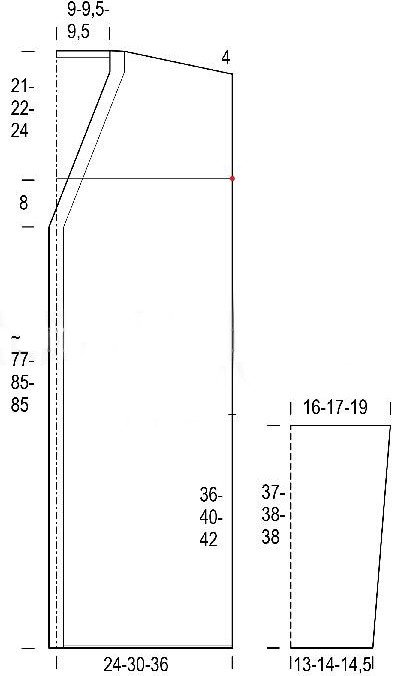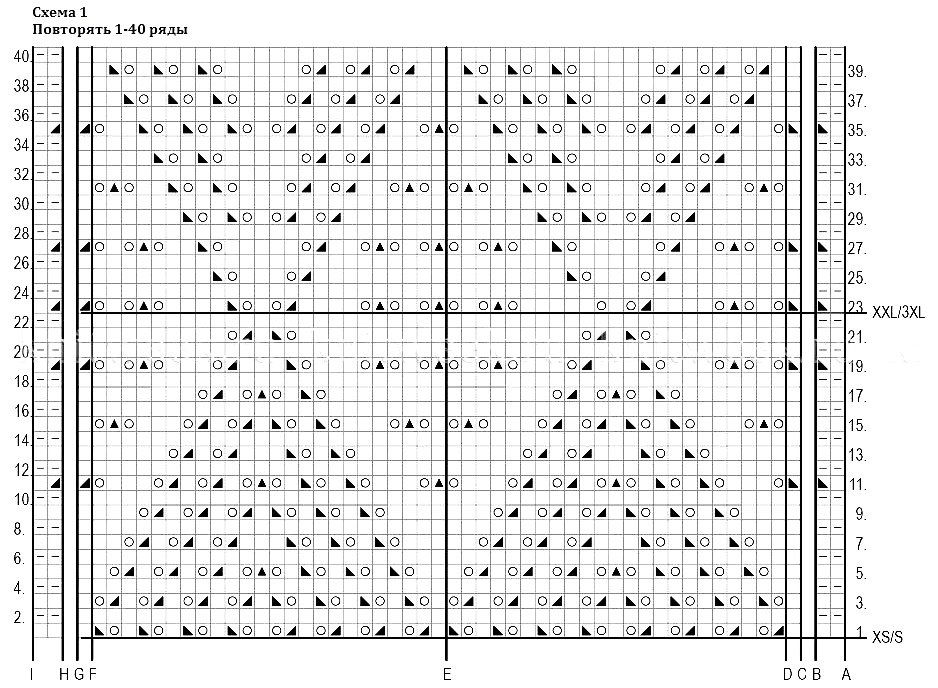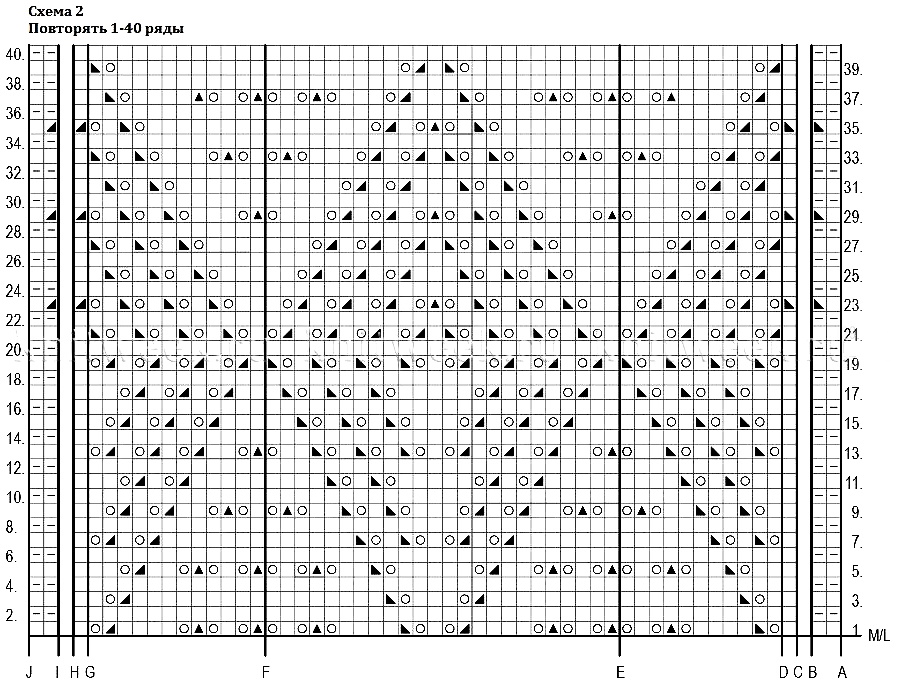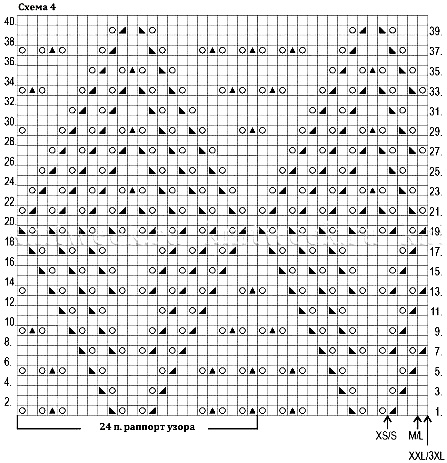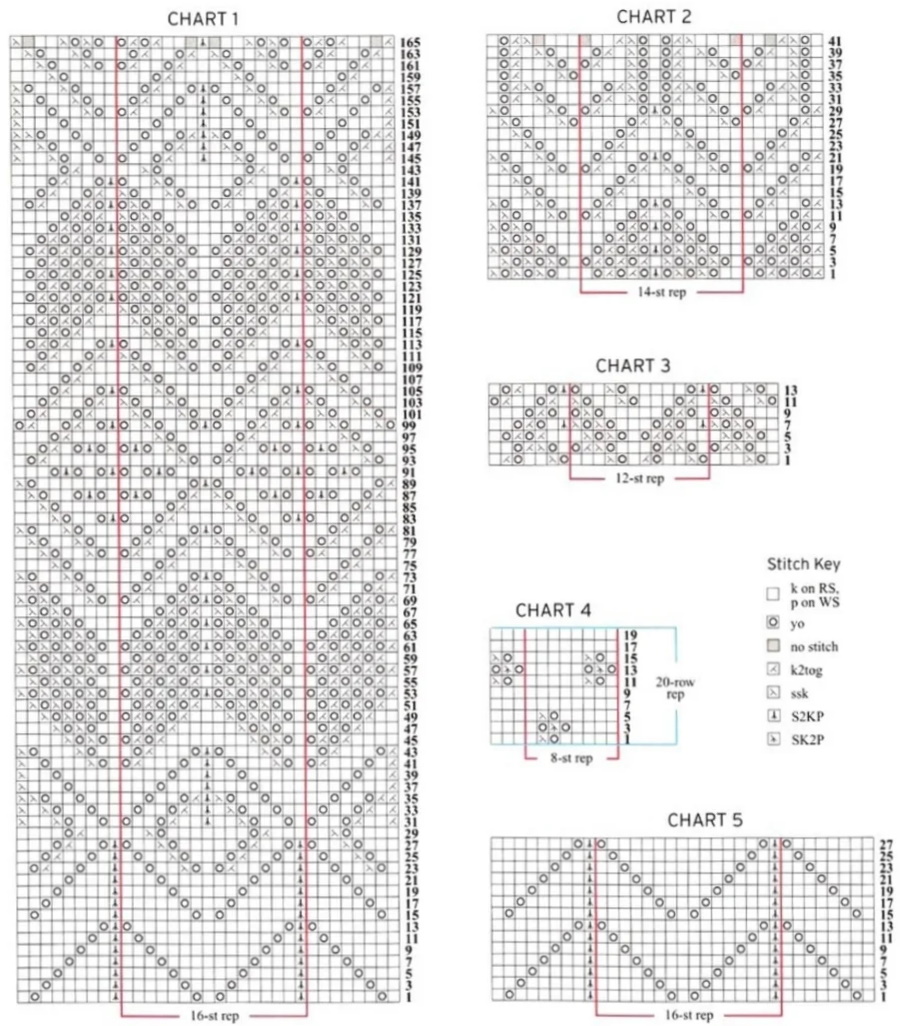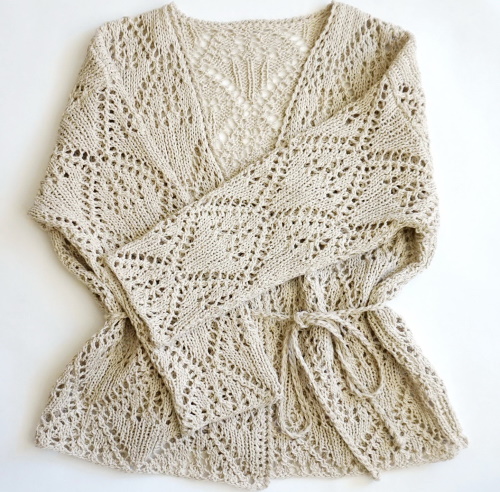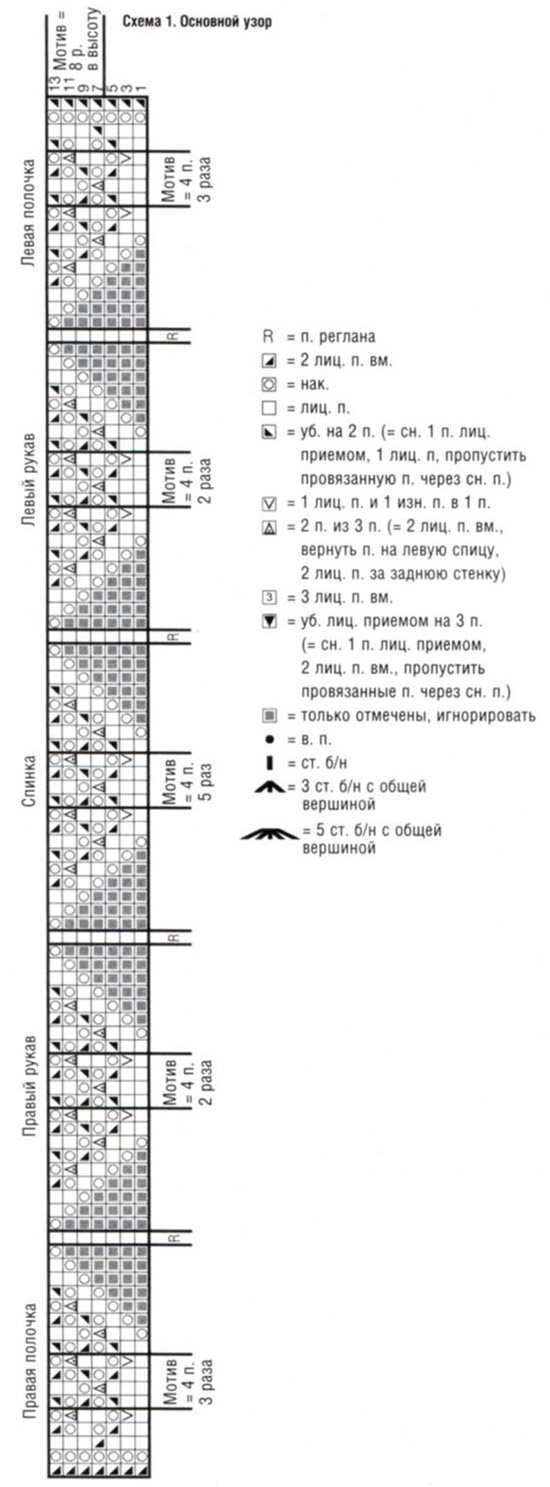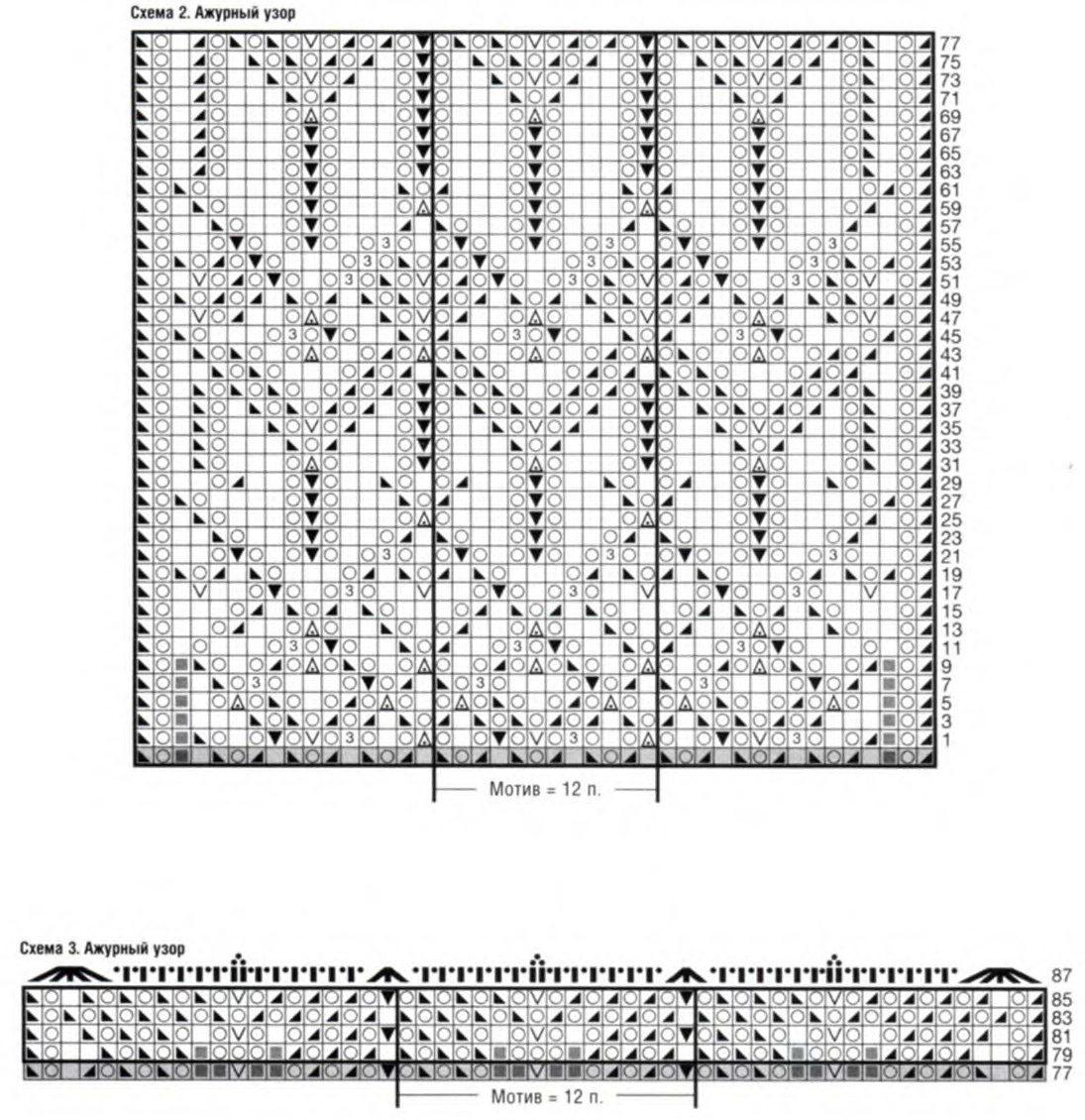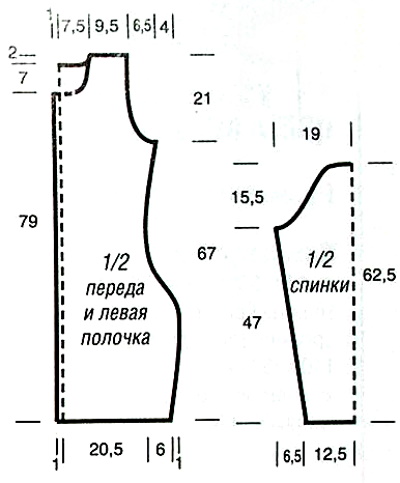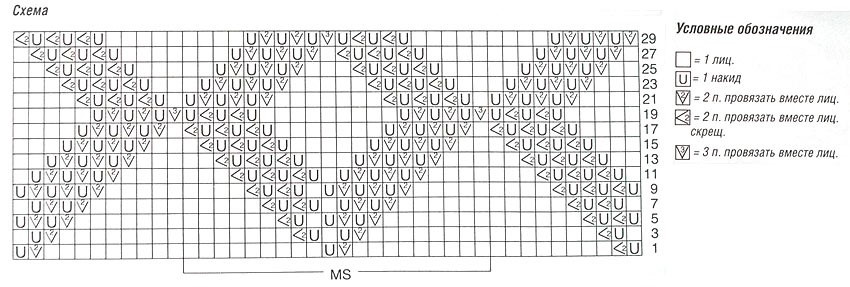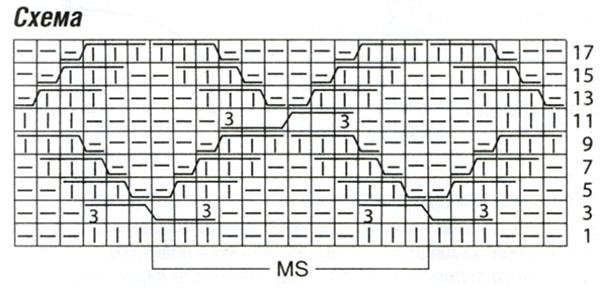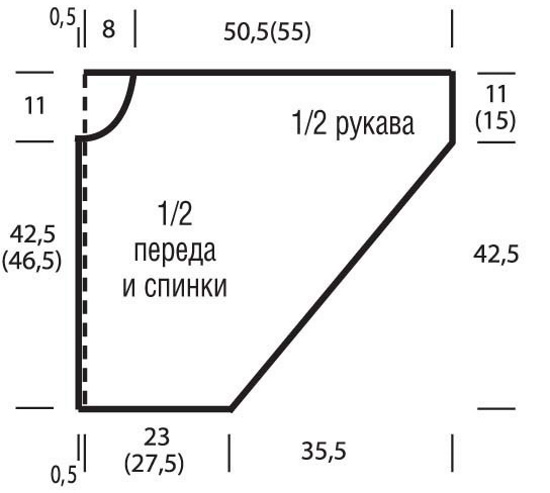No matter what changes fashion has undergone at all times, openwork cardigan made of thin yarn, knitted with knitting needles, always remains in trend. For any weather and for every necessary occasion there is an exclusive model of this attribute of women's wardrobe.
The main criteria for choosing the right style to suit the situation are:
- yarn of the required thickness;
- pattern;
- knitting needles.
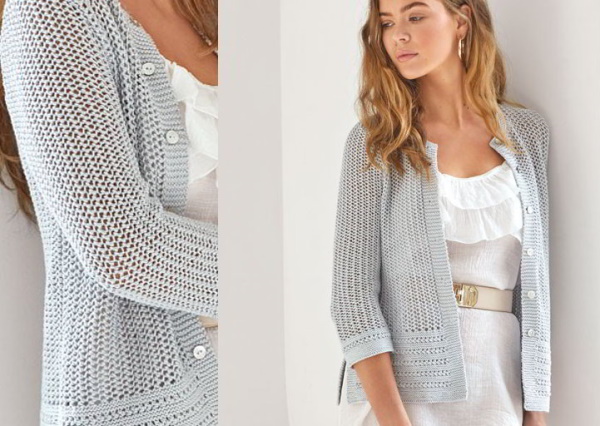
Depending on the desired result, remember that in order for the fabric to be openwork and thin, you should use thin yarn and slightly larger knitting needles. And vice versa, to increase the density of the product, you need to use tools of a smaller diameter.
To avoid a negative outcome, experienced knitters recommend making a small sample of the selected pattern with different types of knitting needles before starting the main work and, having chosen the most optimal option, making further calculations.
Long openwork cardigan
An openwork cardigan knitted with thin yarn requires a lot of preliminary work. It consists of carefully calculating the required number of loops required for the selected size, as well as maintaining symmetry (if the pattern requires it). This once again proves the argument for the need to make a preliminary sample.
As a rule, 2-3 pattern repeats are taken for knitting so that the picture of the future ornament is clearly visible.
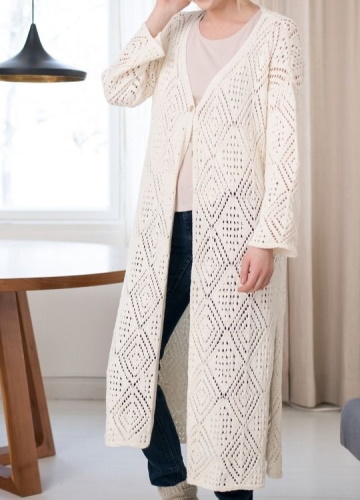
After its production and wet-heat treatment, one rapport is measured and compared with a previously made pattern of the product in full size of the corresponding size (a sample of it is presented below).
In this way, the calculation of the required number of full rapports for knitting the parts of the product is carried out.
If the width of the pattern does not match their whole number, then the remaining section should be divided into 2 equal numbers of loops and evenly distributed between the two rapports to maintain the symmetry of the pattern in the finished product.
The model of the presented openwork cardigan provides 2 design options. The first of them is knitting the main fabric to the armhole level with a solid one-piece pattern. In this situation, the process of sewing side seams is excluded, as well as deformation of the finished product in case of an error in making the back or front parts of the product.
If the cardigan of this model has side slits, then all the parts need to be knitted separately. When performing each part, you should very carefully follow the pattern diagram so as not to miss or knit extra rows. This applies to beginner needlewomen, since experienced knitters already see from the direction of the pattern what manipulations need to be carried out next.
After all the individual parts of the cardigan are knitted, it is assembled. This can be done with a needle and thread or a hook. It should be noted that the second method of making seams looks neater. It is also more reliable than simple stitching.
The presented model does not provide for the design of open cuts, but if you want to give the product originality, you can crochet them. It is advisable not to use openwork for this pattern, since it will not match the main ornament, which is geometric figures. The best option would be a thin edging with "teeth" or "piqué".
Upon completion of the manufacturing process of the entire product, wet-heat treatment is carried out, giving it a finished look.
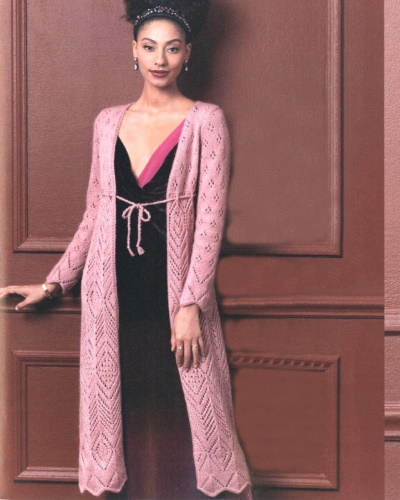
The next presented model arouses interest with its beautiful combination of several patterns, harmoniously flowing from one to another.
A large ornament at the bottom of the garment, followed by a smaller one at the top, visually reduces the woman's shape in the shoulder and chest area, emphasizing the elegance of the large pattern.
And its vertical direction and the finishing detail in the form of a belt located under the chest visually lengthen the model, adding height to the owner of the cardigan.
To correctly calculate the number of loops by the width of the product, it is enough to make a sample of the lower pattern, which will automatically form the subsequent ornament.
The main difficulty in this model is determining the distance from the bottom of the product to the line where the inserted belt will be located. This factor is significant for women with large breast sizes.
The height of the finishing drawstring can be adjusted by adding or excluding several rows of the pattern below. Unlike the previous model, this version is a silhouette that is as close as possible to the woman's figure. Therefore, the armhole and sleeve pattern will have a more complex configuration.
This entails focusing attention when making the upper parts of the product details. When closing the loops to design the armhole and shoulder cap, it is necessary to carefully monitor the preservation of the pattern in order to avoid its distortion and disruption of the appearance of the cardigan.
There are 2 types of patterns offered for making sleeves, the diagrams of which are shown next to each other. But this is not the only option for using them. If desired, you can also use the ornament offered for the lower part of the product.
It will also fit into the overall image in an original way and will not oversaturate it. This cardigan model does not need open cuts, as the main pattern creates a beautiful wave-like finishing effect.
Openwork cardigan with elongated shelves
The openwork cardigan knitted with thin yarn, presented below, has a not quite usual shape. This is due to the modification of the standard pattern. Due to the absence of a neckline on it, the front hem is longer than the rest of the product. And the collar with pointed ends allows you to create a complete image in a set with any dress.
Using various variations of the cardigan, complemented by decorative details in the form of contrasting straps, decorative pins and brooches, you can create many extraordinary looks for any occasion.
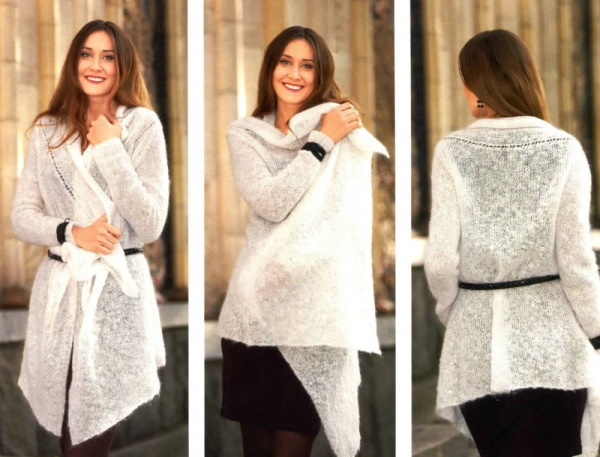
This model can be made in various techniques and directions, as well as using several types of yarn. For example, for a set with a colored dress, a product of a simple texture without a pattern is better suited. For this option, it is great to use thin mohair or cashmere.
A cardigan of one shade, but with an openwork or relief pattern, will also look original with a dress of a single color. The direction of the pattern also brings its own correction to the created image. So, an ornament that has a direction from the bottom up tends to visually add volume to a woman's figure, which will be very useful for a thin figure.
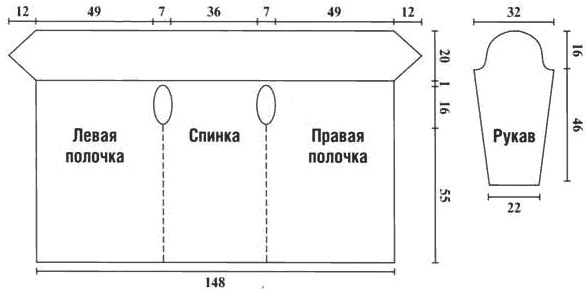
The direction of the pattern from left to right, on the contrary, will give the silhouette femininity and slimness, which will visually increase the height of the woman and hide too protruding parts of the figure.
To ensure lightness and continuity of the entire product, it is recommended to make it in one piece without side seams.
When assembling finished parts, you need to be prepared for the fact that the sleeves will have to be sewn into a closed armhole. Therefore, special attention should be paid to knitting the sleeve cap and matching its width to the armhole. It is impossible to allow either an over-stitching or a lack of curved fabric in this area.
After finishing the work, it is recommended to slightly steam or moisten the product, place it on a horizontal surface and let it dry completely to give it its final shape.
Openwork cardigan of a loose silhouette
An openwork cardigan knitted with thin yarn and a loose cut has many variations.
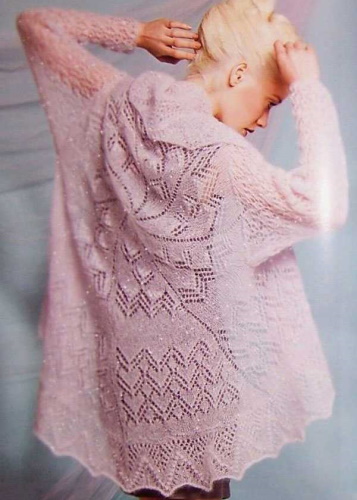
Its components may be:
- simple patterns that fill all the details of the product;
- a combination of several matching ornaments;
- floral or geometric fragments inserted into one or more cardigan pieces;
- separately made elements assembled into a complete composition (patchwork and others).
The configuration of this category of clothing may also vary. The model presented below is evidence of this. Its originality and elegance lies in the technique of execution.
As you can see from the pattern diagram, it is a circle. To knit a product of this shape, you need to have considerable experience working with three and four knitting needles. In addition to them, this technique cannot do without markers, with which the beginning of the row is marked, as well as the location of the armholes.
Any round napkin pattern can be used as the basis for a cardigan pattern made using the circular technique.
When knitting a large diameter item, special attention must be paid to the correct addition of loops to expand it and maintain an even round shape without bulges or ties. Otherwise, this will negatively affect the finished product in the form of bulges or concavities.
The sleeves of this model can also have different configurations.
Their appearance is:
- tapered towards the bottom;
- straight;
- flared at the bottom;
- "bat".
They are made similar to the main pattern or imitate a decorative detail with a contrasting ornament configuration. The cardigan is completed with a soft collar formed by turning up the upper part of the fabric circumference.
The following style of a loose-fitting cardigan is very beautiful and unusual. Its flared shape is formed thanks to the circular knitting technique, which starts from the neck and ends at the bottom edge of the product.
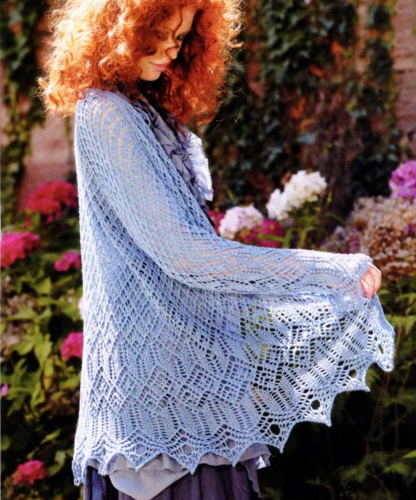
Correct calculation of the number of loops in the neck area guarantees uniform expansion of the fabric, preserving the structure of the pattern.
It should be noted that the sleeves of this style are raglan and are knitted together with the main piece without seams up to the armhole level.
The diagram below shows the uniform distribution of pattern repeats between the future parts of the product.
If you need to create a larger cardigan, add loops at a rate of two (or an even number) for each individual rapport.
Having knitted the initial ornament, and then the small openwork pattern, the diagram of which is also presented below, to the level of the armpits (the beginning of the armholes), the fabric should be divided according to the pattern. After which some more distance of the sleeves and the back with shelves should be knitted according to the same diagram.
When moving on to the execution of individual parts, you should pay attention to the following point. Knitting of a whole piece of fabric from the neck was done in straight and reverse rows. After dividing it into sleeves, back and front pieces, you can switch to circular knitting needles and continue working in a circle without further sewing the edges of the pieces.

But due to the change in knitting technique, the appearance of the ornament itself may change. If this does not contradict the desired result, then the work can be continued. If the differences become more significant, then it is recommended to do the work in the same straight and reverse rows using regular knitting needles.
The next point that requires concentration is the making of the lower part of the sleeves. According to the provided scheme, it is made separately from the main part with an example of decreasing loops.
But in order for this part to be joined to the main fabric correctly, it is necessary to carefully calculate the number of loops in the outer row of the lower part of the sleeve so that their number matches the number in the lower row of the main part of the sleeve. This can be quite difficult for beginner knitters to do.
Therefore, you can use another, simpler option, which consists of continuously knitting the sleeve. To do this, the presented pattern should be read not from the first row, but from the outer one, that is, upside down. In this case, the function of decreasing loops is replaced by the process of adding the same number of them.
The lower part of the cardigan is made according to the provided pattern without changes. The final finishing of the finished product consists of pulling a ribbon or knitted cord through the neck area, which will simultaneously act as a neckline fastener and a bow-shaped fastener.
Openwork cardigan with a hood
An openwork cardigan knitted with thin yarn and a hood gives a certain charm to its wearer. With its help, a slight mystery and unique femininity of the image are created. The peculiarity of the presented model is the close-fitting silhouette of the pattern of the product, its fastener and the presence of a hood.
The pattern used can be very diverse, from geometric to ornate openwork.
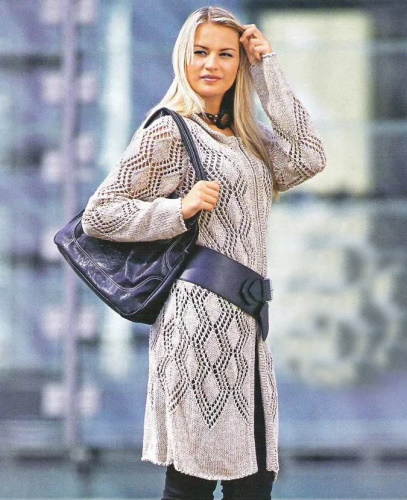
The main emphasis that needs to be paid attention to is the execution of the bottom panel of the cardigan in the area of the side seams.
When adding and decreasing stitches, they should be knitted in such a way that they fit harmoniously into the main pattern without disturbing the overall structure.
The fastener in this model is a zipper sewn onto the front panels of the garment.
To ensure that the fastener is securely fastened to the strips, it is recommended to make them double.
The hood in the presented model is knitted by casting on the required number of loops along the neckline after assembling the main parts. Its shape and volume depend on the woman's wishes. It can be small and shallow or large and flowing.
To knit the second version of the hood shape, you should cast on an additional number of loops, evenly distributed between the main ones. The upper cut is formed by a rounded line or at a right angle. The final wet-heat treatment will give the finished item a finished look.
From square motifs
There are quite a few options for knitting openwork cardigans from square motifs. Below are some of them.
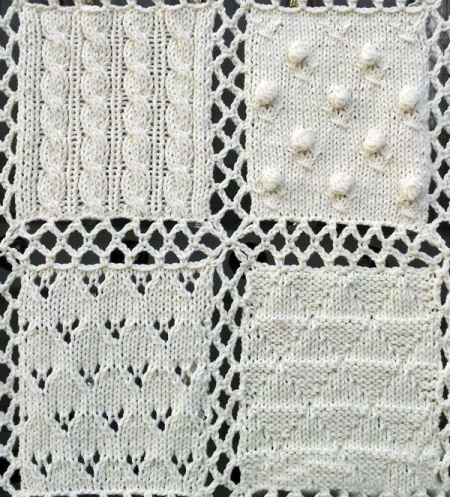
So, the first sample is a composition of square fragments, made on two knitting needles with different patterns and connected with a hook by arcs of air loops. There are also several variations of patterns for squares.
This could be:
- a combination of two or more of their types;
- alternating arrangement of openwork and relief ornaments;
- use of single-color or multi-color elements;
- introducing squares of different types of fabric into the fabric.
The connection of all the motives between themselves also involves several methods:
- by means of a hook;
- using a needle and thread;
- decorative openwork braid, lace or thin cord;
- directly when completing the outer row of the squarest fragment.

The next presented variant is an openwork square, knitted in a floral pattern. The difficulty of its execution is that 3 or 4 hosiery needles are used in the process. For those who do not practice this technique, it will be quite difficult to make such a fragment.
But, having acquired the basic skills of working on several knitting needles, it can become a favorite hobby for a long time. Any things made in this technique are distinguished by their elegance, tenderness, lightness and openwork. Therefore, cardigans from such motifs are suitable for absolutely all occasions.
Experienced knitters warn that not every element may suit the chosen style or size of the product. They emphasize that smooth necklines, sleeve caps, or rounded hemlines are not suitable for clothes made of square elements.
Also, before starting work, it is necessary to make a sample of the square and compare its parameters with the measurements taken. This should be done in order to correctly calculate the number of full fragments for making clothing parts. And if necessary, supplement them with half parts, to maintain the symmetry of the ornament.
Summer openwork cardigan
An openwork cardigan, knitted with knitting needles from thin yarn, arouses interest with its non-standard direction of work. The "highlight" of this model is the original solution, which consists in the symmetrical execution of two halves of the product.
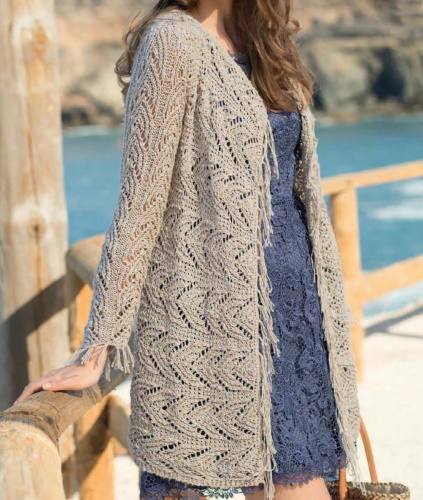
Each of them includes a right front, right sleeve and right back, and a left front, left sleeve and left back.
The connecting seam of two integrally knitted parts is made vertically along the center of the back.
The batwing sleeve style provides complete freedom of movement, making the model comfortable to wear.
The pattern of this cardigan is not difficult to perform, but it requires more time due to the frequent use of an additional knitting needle. But the result will bring maximum pleasure.
All open edges of the fabric are decorated with medium-length fringe made of the same yarn as the main item. Small pieces of thread, folded in half, are pulled upwards from under the loop of the initial row using a hook and the remaining ends are pulled through it.
The resulting loop is tightened. This procedure is repeated through the same number of loops along the entire open edge of the cardigan.
When making knitted items, it is important to remember that they must be washed and dried properly. When washing, it is recommended to use mild liquid substances or shampoos. Dry only in a horizontal position on a hard surface to avoid deformation of the fabric, both in length and width.
Every woman who wants to can create her own image and knit her favorite openwork cardigan from thin yarn.
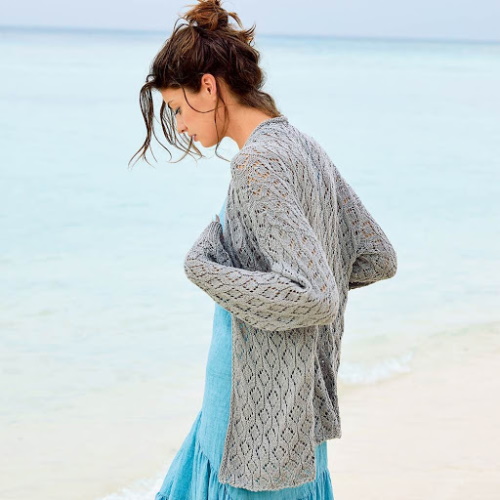
By choosing the simplest option from the models presented in this article, and after acquiring certain skills and techniques, switching to increasingly complex ones, a novice knitter transforms into an experienced master who is capable of creating her own individual masterpieces.
Video about knitting an openwork cardigan with knitting needles
Master class on knitting an openwork cardigan with knitting needles:

